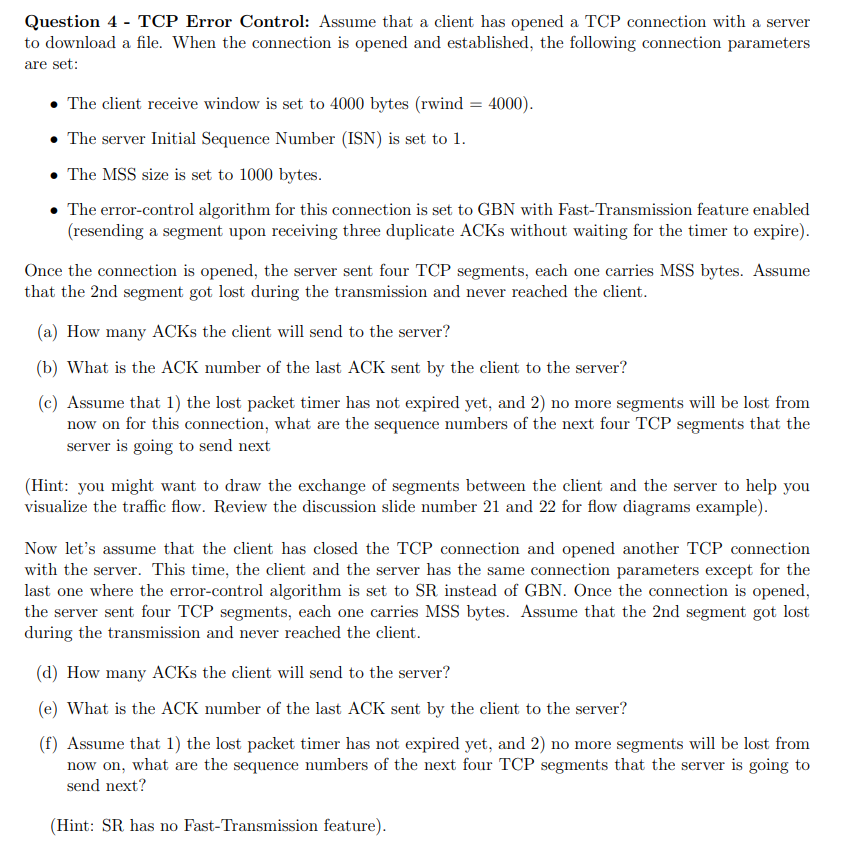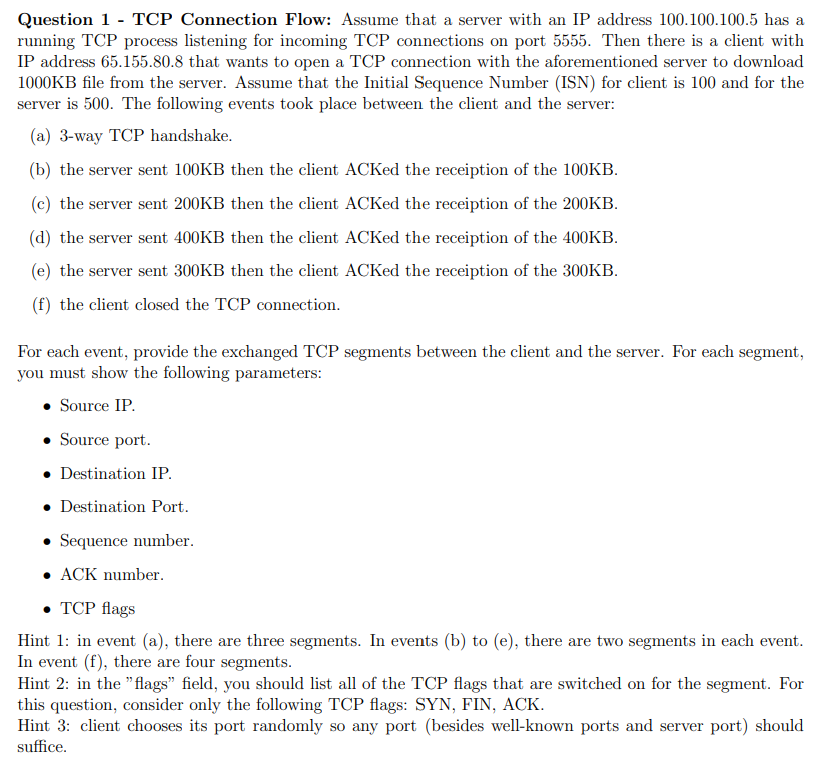Answered step by step
Verified Expert Solution
Question
1 Approved Answer
Question 4 - TCP Error Control: Assume that a client has opened a TCP connection with a server to download a file. When the


Question 4 - TCP Error Control: Assume that a client has opened a TCP connection with a server to download a file. When the connection is opened and established, the following connection parameters are set: The client receive window is set to 4000 bytes (rwind = 4000). The server Initial Sequence Number (ISN) is set to 1. The MSS size is set to 1000 bytes. The error-control algorithm for this connection is set to GBN with Fast-Transmission feature enabled (resending a segment upon receiving three duplicate ACKS without waiting for the timer to expire). Once the connection is opened, the server sent four TCP segments, each one carries MSS bytes. Assume that the 2nd segment got lost during the transmission and never reached the client. (a) How many ACKs the client will send to the server? (b) What is the ACK number of the last ACK sent by the client to the server? (c) Assume that 1) the lost packet timer has not expired yet, and 2) no more segments will be lost from now on for this connection, what are the sequence numbers of the next four TCP segments that the server is going to send next (Hint: you might want to draw the exchange of segments between the client and the server to help you visualize the traffic flow. Review the discussion slide number 21 and 22 for flow diagrams example). Now let's assume that the client has closed the TCP connection and opened another TCP connection with the server. This time, the client and the server has the same connection parameters except for the last one where the error-control algorithm is set to SR instead of GBN. Once the connection is opened, the server sent four TCP segments, each one carries MSS bytes. Assume that the 2nd segment got lost during the transmission and never reached the client. (d) How many ACKs the client will send to the server? (e) What is the ACK number of the last ACK sent by the client to the server? (f) Assume that 1) the lost packet timer has not expired yet, and 2) no more segments will be lost from now on, what are the sequence numbers of the next four TCP segments that the server is going to send next? (Hint: SR has no Fast-Transmission feature). Question 1 - TCP Connection Flow: Assume that a server with an IP address 100.100.100.5 has a running TCP process listening for incoming TCP connections on port 5555. Then there is a client with IP address 65.155.80.8 that wants to open a TCP connection with the aforementioned server to download 1000KB file from the server. Assume that the Initial Sequence Number (ISN) for client is 100 and for the server is 500. The following events took place between the client and the server: (a) 3-way TCP handshake. (b) the server sent 100KB then the client ACKed the receiption of the 100KB. (c) the server sent 200KB then the client ACKed the receiption of the 200KB. (d) the server sent 400KB then the client ACKed the receiption of the 400KB. (e) the server sent 300KB then the client ACKed the receiption of the 300KB. (f) the client closed the TCP connection. For each event, provide the exchanged TCP segments between the client and the server. For each segment, you must show the following parameters: Source IP. Source port. Destination IP. Destination Port. Sequence number. ACK number. TCP flags Hint 1: in event (a), there are three segments. In events (b) to (e), there are two segments in each event. In event (f), there are four segments. Hint 2: in the "flags" field, you should list all of the TCP flags that are switched on for the segment. For this question, consider only the following TCP flags: SYN, FIN, ACK. Hint 3: client chooses its port randomly so any port (besides well-known ports and server port) should suffice.
Step by Step Solution
There are 3 Steps involved in it
Step: 1

Get Instant Access to Expert-Tailored Solutions
See step-by-step solutions with expert insights and AI powered tools for academic success
Step: 2

Step: 3

Ace Your Homework with AI
Get the answers you need in no time with our AI-driven, step-by-step assistance
Get Started


